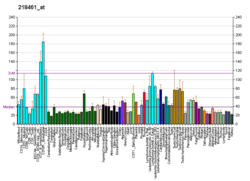| GPN3 |
|---|
|
| Identifiers |
|---|
| Aliases | GPN3, ATPBD1C, GPN-loop GTPase 3 |
|---|
| External IDs | MGI: 1289326; HomoloGene: 6487; GeneCards: GPN3; OMA:GPN3 - orthologs |
|---|
| Gene location (Human) |
|---|
 | | Chr. | Chromosome 12 (human)[1] |
|---|
| | Band | 12q24.11 | Start | 110,452,486 bp[1] |
|---|
| End | 110,469,268 bp[1] |
|---|
|
| Gene location (Mouse) |
|---|
 | | Chr. | Chromosome 5 (mouse)[2] |
|---|
| | Band | 5 F|5 62.33 cM | Start | 122,509,939 bp[2] |
|---|
| End | 122,520,965 bp[2] |
|---|
|
| RNA expression pattern |
|---|
| Bgee | | Human | Mouse (ortholog) |
|---|
| Top expressed in | - Skeletal muscle tissue of biceps brachii
- vastus lateralis muscle
- right ventricle
- gastrocnemius muscle
- kidney tubule
- muscle of thigh
- deltoid muscle
- glomerulus
- right testis
- metanephric glomerulus
|
| | Top expressed in | - morula
- tail of embryo
- blastocyst
- yolk sac
- spermatocyte
- genital tubercle
- embryo
- embryo
- epiblast
- neural layer of retina
|
| | More reference expression data |
|
|---|
| BioGPS |  | | More reference expression data |
|
|---|
|
| Orthologs |
|---|
| Species | Human | Mouse |
|---|
| Entrez | | |
|---|
| Ensembl | | |
|---|
| UniProt | | |
|---|
| RefSeq (mRNA) | |
|---|
NM_001164372
NM_001164373
NM_016301 |
| |
|---|
| RefSeq (protein) | |
|---|
NP_001157844
NP_001157845
NP_057385 |
| |
|---|
| Location (UCSC) | Chr 12: 110.45 – 110.47 Mb | Chr 5: 122.51 – 122.52 Mb |
|---|
| PubMed search | [3] | [4] |
|---|
|
| Wikidata |
| View/Edit Human | View/Edit Mouse |
|


















